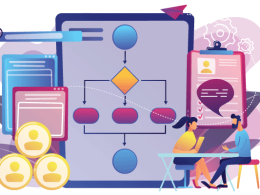Companies invest billions of dollars every year in leadership training programs. Some investments pay off great. While, others, not so much.
Do leadership training programs really work? Yes – they do.
But…the training only works, if done right.
Poor deliverability, less interactive sessions, no practical case studies, wrong learning modem, and so many other things that can go wrong, causing companies to lose millions every year.
So how do you make sure your company’s investment doesn’t go down the drain?
We’ve curated a list of 7 practical ways to improve your leadership training strategy, according to experts. Whether you’re starting your leadership development program from scratch, or you’re an existing program that needs some fixing, 7 practical tips ahead will lay out ways for developing a program that pays off well.
Keep on reading.
7 Practical Ways to Improve Your Leadership Training Strategy
From 2021-2026, the leadership training industry is expected to reach $18.59 billion — growing at the rate of 9.51%. There’s a good reason for this staggering growth. Leadership training just works. (See image below)
But the training program should be something that trains employees in such a way that it truly builds leaders of the future. Read below 7 practical strategies for improving leadership training, for your organization:
1. Embrace Leadership Trends
Leadership training is ever-evolving. Some foundational principles like communication, design thinking, and employee-management sure can be timeless.
But as the world of business evolves through the lens of technology and new workplace trends, there come some leadership trends that become more relevant today — and, in the future. Successful companies ensure that they’re making those trends a priority in their development programs.
For instance, in 2023, the new predicted leadership trends are:
- Hybrid/Remote Team Management
- Empathy
- Growth Mindset
- Diversity & Inclusion
- Removing Unconscious Bias in Business Decisions
- More Flexibility, Autonomy, and Security (Especially true for Genz)
If your company’s 2023 leadership training program lacks these core learnings, it’s likely going to be less effective. Do you know why?
Because…think about it. By 2025, GenZ will make up 27% of the workforce. And GenZ is the generation that ‘wants all’. Job security, better pay, flexibility, autonomy,…you name it.
If your leaders aren’t trained to make important business decisions that address these ‘wants’ — your company is likely going to struggle soon in the future.
So your leadership training strategy should be to include the latest leadership trends that require special training — and that are relevant today and in the future.
2. Make the Training More Interactive
Is your program’s training interactive? Is it all theory? Is it all Powerpoint presentations? Are the learners indulged actively in the training? Are they given any tasks or actionable learning-filled projects to work on and then report back?
The success of your leadership training program relies on how interactive it is. All reading, all videos, and all presentations feel very traditional and classroom-like.
Raine Gui, Director of Model Chic puts it this way: “Understand that you’re training future C-suites. You’re training individuals that can shape your company’s future for good. Or make it worse…depending upon how you train them.”
Take them out of those training rooms. Take them out to events. Take them out to study and survey different companies and their success strategies. Assign them tasks; even as simple as taking their favorite quotes and explaining in front of everyone. These interactions are so important not only for keeping them engaged with the training but also for deep effective learning.
3. Invite Recognized Leaders for Special Sessions
For special presentations, invite recognized leaders to deliver learning-filled lessons. Besides learning, this will make the training more exciting because learners will be able to meet successful experts in the industry. They’ll also be able to see their future selves.
Derek Bruce, Operations Director at Skills Training Group, says, “Those special guests don’t even have to be recognized leaders from social media or from your industry. No worries if they’re not big names. Those special guests can even be from within your company; senior award-winner supervisors, or a company’s role model for the decision-making position.”
4. Include Practical Examples or Case Studies
When we asked how a company can improve their leadership training strategy, Jonathan Merry, Founder & CEO at Bankless Times, said, “Mere theory won’t cut it. Sure, that might have worked if you were training 7-years old with no responsibility. But when you’re training future C-suites, make sure you’re not just “training”, you’re educating, and building characters that feel like born leaders.”
Down to the core.
Include examples and case studies in your theory. Then ask learners to study those, and derive more possible solutions; the different strategies, and thoughtful business decisions they’d make for a given scenario.
What’s that going to do?
That will actually make them ‘think’ and ‘find’ solutions. ‘Critical thinking’ and ‘forging new unique solutions’ — these two are critical traits of a leader. A leader can’t get baffled in times of crisis. Instead, a leader should be calm like a lake even when the massive shift of chaos is happening — and his/her mind should only be thinking about crafting unique solutions that put your company ahead of the competition.
5. Rearrange Theory in a Way That Chapters Are Built Upon Each Other
Design of the program matters. When topics are built upon each other, it makes learning easier, and more coherent.
Learners will love it.
For instance, the ‘communication’ chapter will go before ‘management’ — because to effectively manage the workspace or team, you first need to educate them on how to communicate well.
Sean Stevens, Director of Immerse Education, says, “Take them on a learning journey; from start to finish, designed in a way that chapters make sense. That will not only make the training program more engaging but also more useful.”
Here’s how it will make the training better:
- The connection between the workplace environment of employees, and the course’s content will become more clear.
- The information will become more relevant, and more applicable in real time.
- The knowledge and experiences will go hand in hand, making learning more effective.
- Employees will feel like gradually improving their leadership skills.
- They’ll not only learn, but will be able to execute their learning along the way.
6. Choose the Right Modem
Kelley Van Boxmeer, CEO of Motion Invest, says, “It can be the best training, but if it is not delivered right, it will lose its validity.”
Choose the right modem of delivery: text, presentations, books, or videos.
Short, bite-sized videos are proven to work great. Why? First of all, videos bring the highest level of engagement as both senses of learning become active; listening and visuals.
And the second reason is this: your employees are already hung up on projects. With all that responsibility, reading hours-long theory, books, or course content will only make the training a burden.
But watching hour-long videos and dissecting the important bits is also not the right solution. Ensure the videos are light, and short, and teach one thing at a time.
Jot down to microlearning.
Imagine an employee opening their training portal, and seeing the first video as this length: 02:34:56. Their first thought is likely going to be ‘Two and a half hours?! When I’m gonna finish all of this, and report back tomorrow?!’
Here’s an amazing example of microlearning video training by BigThink. It’s only one and a half minutes long: BigThink.
Therefore, to make your leadership training so that employees actually love to take part, learn, and talk about it, make it bitesize and super-light.
7. Don’t Forget 1:1 Coaching
Include personal coaching in your leadership training program to make it more effective. Coaching can be either internal; from senior staff to junior, or can be external; from an outsider leadership trainer.
“The reason why personal coaching is important in leadership training is that coaching is customized at an individual level. It lasts deep behavioral learning, that almost becomes second nature”, says Tom Miller, Director of Marketing at Fitness Volt.
More reasons are below:
- Since it’s super personalized, coaching helps employees solve the exact challenges, and guides them to success.
- Coaching is practical. It can hardly go wrong. During the sessions, employees can discuss and solve real-world business problems. Which only enhances the learning experience.
- Coaching gives personal space to employees, to even ask the most mundane questions that they might be hesitant to ask in the audience. That helps clear doubts, objections, and fears.
Concluding: Ready to Develop a Leadership Training Program That Actually Works?
I’ll sign off with an important quote from Joe Troyer, CEO of ReviewGrower & Digital Triggers, “Leadership training isn’t essentially a course with tips and tricks, like communicating well or managing this and that. It’s much deeper than that. Leadership training, at the core, is a mindset shift. It’s about evaluating existing beliefs of employees; what they might ‘think’ about leadership, and what it actually means to become a leader.”
That change of mindset is critical because those important positions will take the lead. If the leader gets baffled, and if the leader’s foundation is based on some tips and tricks, then your company might fumble in the changing landscape of business.
Coach on a personal level, mentor, provide personal level training, include exercises that shift personalities, and base your training on some practical case studies or projects. That’s when you truly build the leaders of the future.
Author Bio:

Lachlan de Crespigny is the co-founder of Revelo, a technology company offering the largest online platform for U.S. companies to hire remote software developers. Representing a talent pool of 100K Latin America-based technology professionals, Revelo’s platform enables U.S. companies to source, hire, and manage highly qualified, English-speaking, time zone-aligned, full-time remote tech talent.
With services including managing payroll, candidate benefits, taxes, and local compliance, Revelo provides an end-to-end, turnkey solution for sourcing, hiring, and managing hard-to-find software developers quickly and easily. Revelo has helped hundreds of companies, from startups to Fortune 500s, build and scale their engineering teams.

















